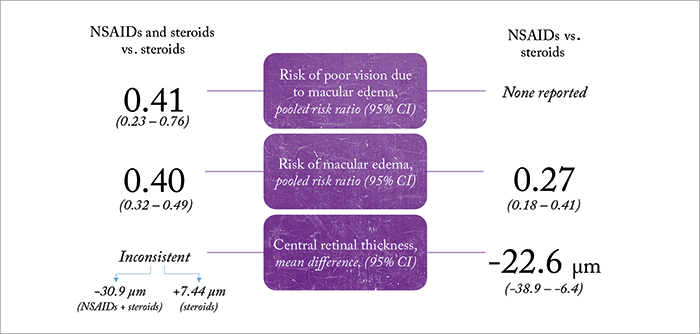
Macular edema (ME) following cataract surgery isn’t fun for anyone. Although it’s usually self-limiting, it’s particularly bad news for patients’ vision if it persists. That’s why most surgeons like to take a prophylactic approach to ME and use topical steroids and/or topical non-steroidal anti-inflammatory drugs (NSAIDs) before and after surgery. But a recently-published Cochrane Eyes and Vision systematic review might change that perception.
Their review incorporated results from 34 randomized controlled trials that involved over 5,000 patients who received surgery for age-related cataract that reported ME incidence. Of those, 28 studies compared NSAIDs and steroids versus steroids alone, and the remaining six compared NSAIDs directly with steroids. They found:
- At three months post-op, the risk of poor vision secondary to ME was lower in patients who received NSAIDs and steroids, than steroids alone – but this was classed as “low certainty evidence.”
- Also classed as “low certainty” was evidence of a reduced risk of NSAIDs and ME at three months post-op.
- Almost no evidence was found that NSAIDs improve outcomes for patients, with only one study reporting on quality of life – and even then, stated only that there was a “lack of differences between groups.”
- Inconsistent data regarding central retinal thickness at three months post-surgery (I² = 87%), and little difference in reported BCVA outcomes (inter-group differences were less than 0.1 LogMAR in 31 out of 34 studies).
- The most notable adverse effects associated with NSAIDs were burning or stinging; there was no evidence of serious adverse effects.
So what’s the take home message? Blanche Lim, lead author on the paper explains: “Topical NSAIDs may be beneficial as prophylaxis against ME, however there remains a lack of compelling evidence to suggest any visual benefit in the long run. There is also a paucity of data to determine effectivity in certain at-risk subgroups.” The authors note that future trials are needed to clear up the uncertainty. In the meantime, Lim comments “The inclusion of NSAIDs as a standard regimen perioperatively still remains surgeon-dependent.”
References
- BX Lim et al., “Prophylactic non-steroidal anti-inflammatory drugs for the prevention of macular oedema after cataract surgery”, Cochrane Database Syst Rev, 11 (2016). [Epub ahead of print]. PMID: 27801522.
